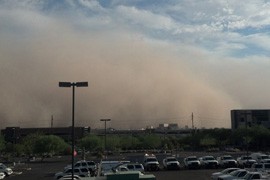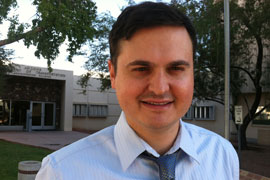Cronkite News has moved to a new home at cronkitenews.azpbs.org. Use this site to search archives from 2011 to May 2015. You can search the new site for current stories.
State agencies cooperate to cut dust storm crashes
PHOENIX – State departments working together to prevent fatal vehicle crashes in Pinal County dust storms say the joint efforts may be helping.
“Our No. 1 priority is public safety,” said Dustin Krugel, public information officer for the Arizona Department of Transportation. “These dust storms can be extremely dangerous. They can limit visibility and create chain-collision crashes.”
After a massive October 2011 dust storm that triggered multi-car pileups, one death and 15 injuries in the Casa Grande area, ADOT began working with the Arizona Department of Public Safety, the National Weather Service and the Governor’s Office of Highway Safety on ways to educate motorists.
One result was a radio and television public awareness campaign urging drivers to “pull aside to stay alive.”
“We’ve done dust storm campaigns before, but this one was unique because we are telling drivers, ‘You don’t want to get caught in a dust storm,’” Krugel said. “If you see bad conditions ahead, that’s when you need to pull over, not when you’re caught in the middle of a dust storm.”
Bart Graves, a DPS spokesman, put it more bluntly.
“Drivers kill drivers,” he said. “The reason people die in dust storms is that they think they can power through it.”
Since the fatal storm last year, no more deaths have been attributed to haboobs. But that might be because dust storms were less severe.
The Arizona Department of Environmental Quality, under order from the EPA to address particulate pollution in western Pinal County, is conducting an inventory of the causes of dust storms from a public health standpoint.
“Particulate matter can be emitted from lots of different sources: agriculture, vacant lots, dirt roads, but you also get emissions from industrial sources,” said Trevor Baggiore, deputy director of the department’s Air Quality Division.
He added that Pinal County’s stakeholders would have to decide on the most affordable and effective solutions.
“There’s obviously paving, which is expensive, but that’s an option. Gravel or some other type of dust-suppressing surface is an option.
They also make a liquid you spray on the surface – you can use water too,” Baggiore said. “Ultimately, there’s other things too, like speed limits, preventing access, options like that.”
Don Gabrielson, director of the Pinal County Air Quality Control District, said a logical solution would be reducing the speed limit.
“But to what extent are you going to tell people to drive 55 because every couple of years there’s a fatality?” he asked.
One factor that may be making a difference this year is the weather service’s efforts to predict dust storms more quickly, so that ADOT can warn drivers in enough time for them to delay a trip or reroute it.
“I’d like to think our work is helping,” said Ken Waters, warning coordination meteorologist with the weather service. “This in no way is a done deal. We’re still learning about detection and prediction, and we will continue to work with many agencies.”
An ADOT project along I-10 between Willcox and the New Mexico line uses signs to alert drivers to windy conditions and gives them a radio station to tune in to for tips. In addition, ADOT is using social media to update motorists and sending more advisories to the news media.
“There are really no feasible solutions that ADOT could install to prevent dust from crossing the highway,” Krugel said. “Our focus will continue to be to educate drivers to make sure they know what to do and be prepared.”
Preparation will help, since experts agree that Arizona will never completely get rid of dust storms.
“Hopefully some of these control measures will help minimize the amount of dust,” Baggiore said, “but we fully expect dust storms to continue happening.”
Education helps with Arizona residents, but Graves is concerned about out-of-state drivers and Spanish speakers who may not be able to read overhead warning messages.
“Driving in a dust storm is rolling the dice,” he said.
Variability with drought and construction can also affect the odds of a severe storm, according to Pinal County’s Don Gabrielson.
“A look in the rearview mirror says our efforts have been working or we’ve been lucky,” he said. “Let’s hope it continues.”








